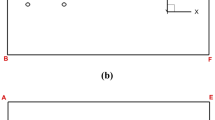Summary
Some theoretical models have been developed during the last twenty five years for the dispersion of a stack plume with a density larger than air. Also experiments have been carried out to investigate the properties of suck heavy plumes. A critical review about these models and experiments has been written.
Access this chapter
Tax calculation will be finalised at checkout
Purchases are for personal use only
Preview
Unable to display preview. Download preview PDF.
Similar content being viewed by others
References
Schatzmann, M.: Auftriebstrahlen in natürlichen Strömungen, Entwicklung eines mathematischen Modells. Dissertation, Universität Karlsruhe 1976
Bosanquet, C.H.: The rise of a hot waste gas plume. J. of the Institute of Fuel 30 (1957) 322.
Hoot, T.G.; Meroney, R.N.; Peterka, J.A.: Wind tunnel tests of negatively buoyant plumes. Fluid Dynamics/Diffusion Laboratory, Colorado State University, Colorado 80521, 1973.
Hoult, D.P.; Fay, J.A.; Forney, L.J.: A theory of plume rise compared with field observations. J. Air. Poll. Control Ass. 19 (1969) 585.
Ooms, G.; Mahieu, A.P.; Zelis, F.: The plume path of vent gases heavier than air. First International Symposium on Loss Prevention and Safety Promotion in the Process Industries. The Hague 1974.
Keffer, J.F.; Baines, W.D.: The round turbulent jet in a cross wind. J. Fluid Mech 15 (1963) 481.
Ooms, G.; Mahieu, A.P.: A comparison between a plume path model and a virtual point source model for a stack plume. Appl. Sci. Res. 36 (1981) 339.
Singer, I.A.; Smith, N.E.:’ Atmospheric dispersion at Brookhaven National Laboratory. Int. J. Air and Water Pollution 10 (1966) 125.
Chu, V.H.: Turbulent dense plumes in laminar cross flow. J. Hydraulic Research 13 (1975) 263.
Bloom, S.G. A mathematical model for reactive negatively buoyant atmospheric plumes. Symposium on Heavy Gas. Frankfurt 1980.
Gifford, M.F.: An outline of theories of diffusion in the lower layer of the atmosphere. U.S. AEC Report No. TID-24190, 1968.
Hirst, E.A.: Analysis of round, turbulent, buoyant jets discharged to flowing stratified ambients. U.S. AEC Report No. ORNL-4685, 1971.
Turner, J.S.: Jets and Plumes with negative or reversing buoyancy. J. Fluid Mech 26 (1966) 779.
Bodurtha, F.T.: The behaviour of dense stack gases. J. Air Poll. Control Assoc. 11 (1961) 431.
Hoehne, V.O.; Luce, R.G.: The effect of velocity, temperature and molecular weight on iiiflammibility limits in wind blown jets of hydrocarbon gases. Proc. Div. of Refining, American Petroleum Institute, 35th Mid Year Meeting 1970.
Holly, F.M.; Grace, J.L.: Model study of dense jet in flowing fluid. J. of Hydr. Div., Proc. of the ASCE 98 /9365 (1972) 1921.
Meroney, R.N.: Wind-tunnel experiments on dense gas dispersion. J. Hazardous Materials 6 (1982) 85.
Anderson, J.L.; Parker, F.L.; Benedict, B.A.: Negatively buoyant jets in a cross flow, EPA–Report No. 660/2–73–012, 1973.
Abraham, G.: Round buoyant jet in cross flow. 5th International Conference on Water Pollution Research. San Francisco 1970.
Badr, A.: Temperature measurements in a negatively buoyant round vertical jet issued in a horizontal cross flow. IUTAM Symposium “Atmospheric Dispersion of heavy gases and small particles”, Scheveningen, The Netherlands 1983.
Britter, R.E.; Hunt, J.C.R.; Marsh, G.L.; Snyder, W.H.: The effects of stable stratification on turbulent diffusion and the decay of grid turbulence. J. Fluid Mech. 127 (1983) 27.
Ccanady, G.T.: Turbulent diffusion in a stratified fluid. J. of Atmospheric Science 21 (1964) 439.
Jones, W.P.; McGuirk, J.J.: Computation of a round turbulent jet discharging into a confined cross flow. Second Symposium on Turbulent Shear Flow, London 1980.
Author information
Authors and Affiliations
Editor information
Editors and Affiliations
Rights and permissions
Copyright information
© 1984 Springer-Verlag Berlin, Heidelberg
About this paper
Cite this paper
Ooms, G., Duijm, N.J. (1984). Dispersion of a Stack Plume Heavier than Air. In: Ooms, G., Tennekes, H. (eds) Atmospheric Dispersion of Heavy Gases and Small Particles. International Union of Theoretical and Applied Mechanics. Springer, Berlin, Heidelberg. https://doi.org/10.1007/978-3-642-82289-6_1
Download citation
DOI: https://doi.org/10.1007/978-3-642-82289-6_1
Publisher Name: Springer, Berlin, Heidelberg
Print ISBN: 978-3-642-82291-9
Online ISBN: 978-3-642-82289-6
eBook Packages: Springer Book Archive




